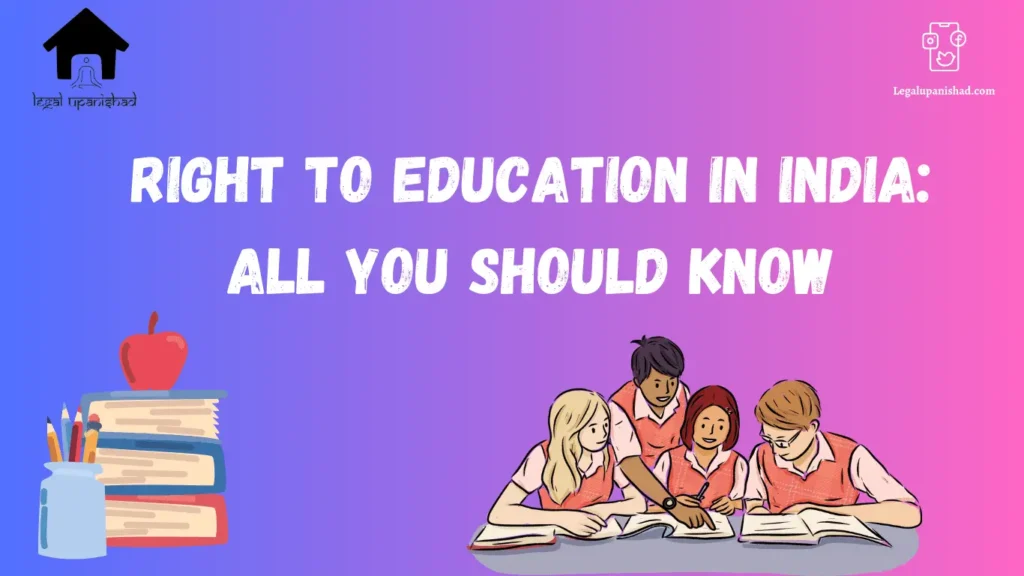This article on ‘Right to Education in India: All You Need to Know’ was written by Toya Sen, an intern at Legal Upanishad.
INTRODUCTION
Education plays a major role in a child’s life. It is needed to inculcate a child’s problem-solving, analytical, and creative skills. Therefore, access to education is extremely important for every child irrespective of socio-economic background, class, caste, gender, place of birth, etc. Education does not only help a child gain the aforementioned skills but also unlocks a sense of justice and injustice, knowledge, ethics, and attitudes that would make them responsible and active citizens of our country.
India is a particularly young country with the majority of the population consisting of school-going and working adults, education becomes a vital part of the country’s development. Illiteracy is a major problem that resides in India. To tackle these problems, the Government of India introduced the right to free and compulsory education as a fundamental right for children aged 6-14 years. In this article, we will be discussing the right to education in India.
RIGHT TO EDUCATION
The Right to Education ensures that every child in India gets primary education. Article 21-A states “The State shall provide free and compulsory education to all the children of the age of six to fourteen years in such a manner as the state may, by law, determine” This gave every child a right to have elementary education and an opportunity to attend schools. The term ‘free education’ means, those children with poor financial backing will be given free education in the neighborhood or state they are residing in.
Initially, the right to education was not considered a fundamental right in the Indian Constitution. However, it was mentioned as a Directive Principle of State Policy under Article 45. Article 45 stated that the state had a responsibility to provide free and compulsory education to all children up to the age of 14 within 10 years of the Constitution’s commencement. This provision applied to children at any stage of education, not just primary education. The Supreme Court also clarified that the state could fulfill this obligation by supporting government-aided schools and was not obligated to do so at the expense of minority communities.


86TH CONSTITUTIONAL AMENDMENT ACT
The 86th Constitutional Amendment Act of 2002 made major changes to the Indian Constitution to protect and promote the right to education for its citizens, particularly for children between the ages of six and fourteen (6-14). These changes aimed to improve the educational system and provide better opportunities for people in India to receive an education, thus transforming their lives for the better.
The key changes brought about by the amendment are:
- Addition of Article 21A: This article was inserted in Part III of the Indian Constitution. It recognizes that every child is enshrined with the right to compulsory and free education. This article also set up rules and guidelines that need to be followed to provide education.
- Modification of Article 45: Article 45 was altered and modified to emphasize the state’s responsibility in ensuring that children get early education compulsorily and free in nature until they reach the age of 6. This change acknowledges the importance of early education in a child’s development.
- Addition of Clause (K) under Article 51A: A new fundamental duty was added under Article 51A. This clause states that parents and guardians have the duty to provide education and various other opportunities to their children who are between the ages of 6 to 14. It emphasizes the role of parents and guardians in facilitating their children’s education.
RIGHT TO EDUCATION ACT, 2009
In the year 2009, The Parliament passed the Right to Education Act (RTE). This act is considered to be a significant landmark in the history of education in India. After many rounds of drafting and redrafting, the Parliament finally passed this act with a policy known as the ‘4A policy’.
- Availability- This means that education is free of cost and the government is required to fund the education of children; there are sufficient well-qualified teachers and adequate infrastructure to support educational institutions.
- Accessibility– This means that education shall be accessible to all without a sense of discrimination, especially in regards to weaker sections of society.
- Acceptability– This means that the content and value of education that is being taught are appropriate and non-discriminatory and culturally acceptable in nature. The schools should be harmless with well-qualified teachers.
- Adaptability – That education needs to be developed with changing needs of society and contributes to overcoming inequalities seen in society such as sex discrimination
Main Features of this Act:
- A child cannot be expelled, repeat a grade, or be mandatory to pass a board examination until they complete elementary education.
- If a child above the age of 6 has not been enrolled in any school or has yet to complete elementary education, they will be admitted that would be class appropriate for their age. However, if a child needs to be enrolled in a lower class to catch up with their peers, they are entitled to receive special training and care for a specified duration. Regardless of age, every child has the right to elementary education and is guaranteed education that is free until they complete it, even if they exceed the age of 14.
- The proof of a child’s age for admission to elementary education will be based on the birth certificate issued under the Birth, Marriages, and Death Registration Act of 1856, or other documents mentioned in the annexure. Lack of age proof or other documents should not prevent a child from being admitted to school.
- A certificate will be provided to a child upon completion of elementary education.
- Regular assessments and attendance will be conducted to maintain a fixed student-teacher ratio.
- Private schools must reserve 25% of their admissions in Class I for economically disadvantaged and weaker communities.
- Continuous efforts will be made to improve the quality of education.
- School teachers will be required to obtain adequate professional degrees within five years. Failure to fulfill this condition may result in job loss.
- School infrastructure will be improved every three years. If a school fails to meet the infrastructure requirements, its recognition may be cancelled.
- The financial responsibility for education will be shared between the central and state governments, as education falls under the concurrent list.
CONSTITUTIONAL PROVISIONS
- Article 28: Liberty to attend any religious educational institutions.
- Article 29: Deals with equality of opportunity in educational institutions.
- Article 30: Recognizes the rights of minorities and gives them permission to create and run educational institutions.
- Article 45: The state must make sure to provide free and compulsory education to all children until they have attained the age of 14 years. The duty of providing education lies in the hand of all government and local bodies and organizations.
- Article 46: Special attention to be provided for the upliftment of weaker sections in society such as Schedule Castes, Schedule Tribes, and OBCs.
- Article 337: Deals with the regulations concerning educational grants in regards to the Anglo-Indian Community.
- Article 350B: Deals with the endowments and offers that are for the linguistic minorities.
- Article 351: Development and promotion of the Hindi language.
CONCLUSION
Education is the most important tool for the development of a child as well as the country. A child cannot, therefore, succeed in life without education. It is a building block for a child’s successive career. To summarize, the Right to Education provides free and compulsory education to children aged 6-14 years. This right makes it possible for those parents who cannot send their children to school because of their financial situation and the opportunity to develop their child’s analytical and creative skills and make them responsible citizens. It also allows the weaker section of society to gain education and uplift them and the ones around them too.
LIST OF REFERENCES
- Amrapali Mukherjee, Right To Education – A Fundamental Right (Article 21-A), Law Corner, 19 January 2023, available at: https://lawcorner.in/right-to-education-a-fundamental-right-article-21-a/
- Amruta Patil, Right to Education (Article 21A) – Indian Polity Notes, Prepp, 6 November 2023, available at: https://prepp.in/news/e-492-right-to-education-article-21aindian-polity-notes
- Akash R. Goswami, Right To Education, iPleaders Blog, 29 July 2019, available at: https://blog.ipleaders.in/right-to-education-3/

